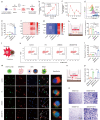Proinflammatory polarization of engineered heat-inducible macrophages reprogram the tumor immune microenvironment during cancer immunotherapy
- PMID: 38491004
- PMCID: PMC10943244
- DOI: 10.1038/s41467-024-46210-1
Proinflammatory polarization of engineered heat-inducible macrophages reprogram the tumor immune microenvironment during cancer immunotherapy
Abstract
The success of macrophage-based adoptive cell therapy is largely constrained by poor polarization from alternatively activated (M2-like) to classically activated (M1-like) phenotype in the immunosuppressive tumor microenvironment (TME). Here, we show that the engineered macrophage (eMac) with a heat-inducible genetic switch can induce both self-polarization of adoptively transferred eMac and re-polarization of tumour-associated macrophages in response to mild temperature elevation in a mouse model. The locoregional production of proinflammatory cytokines by eMac in the TME dose not only induces the strong polarization of macrophages into a classically activated phenotype, but also ensures that the side effects typical for systemically administrate proinflammatory cytokines are avoided. We also present a wearable warming device which is adaptable for human patients and can be remotely controlled by a smartphone. In summary, our work represents a safe and efficient adoptive transfer immunotherapy method with potential for human translation.
© 2024. The Author(s).
Conflict of interest statement
The authors declare no competing interests.
Figures







Similar articles
-
Adoptive transfer of Fe3O4-SWCNT engineered M1-like macrophages for magnetic resonance imaging and enhanced cancer immunotherapy.Colloids Surf B Biointerfaces. 2023 Sep;229:113452. doi: 10.1016/j.colsurfb.2023.113452. Epub 2023 Jul 11. Colloids Surf B Biointerfaces. 2023. PMID: 37474429
-
Tumor microenvironment remodeling via targeted depletion of M2-like tumor-associated macrophages for cancer immunotherapy.Acta Biomater. 2023 Apr 1;160:239-251. doi: 10.1016/j.actbio.2023.02.006. Epub 2023 Feb 11. Acta Biomater. 2023. PMID: 36774974
-
Escherichia coli adhesion portion FimH polarizes M2 macrophages to M1 macrophages in tumor microenvironment via toll-like receptor 4.Front Immunol. 2023 Sep 1;14:1213467. doi: 10.3389/fimmu.2023.1213467. eCollection 2023. Front Immunol. 2023. PMID: 37720226 Free PMC article.
-
Shaping Polarization Of Tumor-Associated Macrophages In Cancer Immunotherapy.Front Immunol. 2022 Jun 30;13:888713. doi: 10.3389/fimmu.2022.888713. eCollection 2022. Front Immunol. 2022. PMID: 35844605 Free PMC article. Review.
-
Autophagy drives plasticity and functional polarization of tumor-associated macrophages.IUBMB Life. 2022 Feb;74(2):157-169. doi: 10.1002/iub.2543. Epub 2021 Aug 31. IUBMB Life. 2022. PMID: 34467634 Review.
Cited by
-
Dual-targeted microbubbles for atherosclerosis therapy: Inducing M1 macrophage apoptosis by inhibiting telomerase activity.Mater Today Bio. 2025 Mar 20;32:101675. doi: 10.1016/j.mtbio.2025.101675. eCollection 2025 Jun. Mater Today Bio. 2025. PMID: 40225135 Free PMC article.
-
Innovative Hydrogel Design: Tailoring Immunomodulation for Optimal Chronic Wound Recovery.Adv Sci (Weinh). 2025 Jan;12(2):e2412360. doi: 10.1002/advs.202412360. Epub 2024 Nov 22. Adv Sci (Weinh). 2025. PMID: 39575827 Free PMC article. Review.
-
Altered Atlas of Exercise-Responsive MicroRNAs Revealing miR-29a-3p Attacks Armored and Cold Tumors and Boosts Anti-B7-H3 Therapy.Research (Wash D C). 2025 Jan 22;8:0590. doi: 10.34133/research.0590. eCollection 2025. Research (Wash D C). 2025. PMID: 39845707 Free PMC article.
-
Carbon Dot-Linked Hydrogel for TAMs Transform: Spatiotemporal Manipulation to Reshape Tumor Microenvironment.Adv Mater. 2025 May;37(20):e2420068. doi: 10.1002/adma.202420068. Epub 2025 Apr 3. Adv Mater. 2025. PMID: 40181663 Free PMC article.
-
Homologous-adhering/targeting cell membrane- and cell-mediated delivery systems: a cancer-catch-cancer strategy in cancer therapy.Regen Biomater. 2024 Nov 21;12:rbae135. doi: 10.1093/rb/rbae135. eCollection 2025. Regen Biomater. 2024. PMID: 39811105 Free PMC article. Review.
References
MeSH terms
Substances
Grants and funding
LinkOut - more resources
Full Text Sources
Medical

